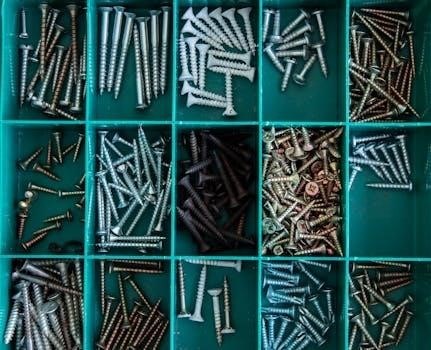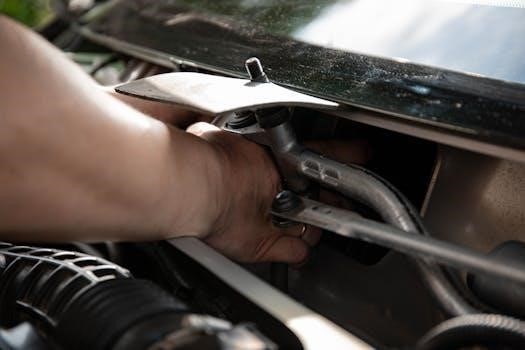Honeywell T4 Pro Installation Overview
The Honeywell T4 Pro thermostat is designed for easy and efficient home temperature control. Installation involves understanding your system, wiring, and mounting the device. This guide provides an overview of the process, including power options, wiring diagrams, and initial setup steps. This ensures a straightforward installation process.
Identifying T4 Pro Models
The Honeywell T4 series includes both the T4 and T4 Pro models, distinguishable by a key feature⁚ the presence of a display screen. If your thermostat has a visible display screen, it is the T4 Pro model. Conversely, if your thermostat lacks a display screen, it is identified as the standard T4 model. This simple visual difference is crucial for selecting the correct installation procedures. The T4 Pro offers programmable features, enhancing its usability for managing your home’s heating and cooling. Understanding this basic distinction is the first step in ensuring you use the correct installation guide and associated instructions tailored to your specific model. This clear difference simplifies identification and helps avoid confusion during the installation process. It is important to verify your model for successful setup. Always refer to the corresponding manual for your exact model type.
Distinguishing Between Square and Rectangular Cover Plates
Honeywell T4 series thermostats use two different cover plate shapes, square and rectangular, that correspond directly with the T4 Pro or T4 models. The T4 Pro, identified by its display screen, is paired with a square cover plate. If your thermostat has a display, it will have a square cover plate. Conversely, the standard T4 model, which does not feature a display screen, uses a rectangular cover plate. The cover plate shape is directly correlated to the model; this simplifies selection during installation and replacement. This identification process is critical to ensure proper fit and aesthetic alignment with your installation. Knowing the correct cover plate shape allows users to install the right cover plate the first time. Always confirm the shape according to the presence of a display screen. This differentiation is key for a correct setup. It is essential for proper mounting. Always consult the user manual for visual verification.

Optional Cover Plate Installation
The optional cover plate is used when mounting the thermostat over an electrical junction box or to cover any gaps from the previous thermostat. It is not always required.
When to Use the Optional Cover Plate
The optional cover plate for the Honeywell T4 Pro thermostat is a useful accessory in specific installation scenarios. Primarily, it serves a dual purpose⁚ to provide a secure mounting surface when the thermostat is being installed over an existing electrical junction box and to conceal any unsightly gaps or marks left by a previous thermostat installation. The cover plate ensures a clean and professional finish, avoiding the need for wall repairs. Furthermore, if the original thermostat was larger or had a different shape, the cover plate can effectively hide any exposed areas of the wall, creating a seamless look. It also provides a larger surface for the thermostat to attach to, adding stability. In essence, the optional cover plate is a practical solution for both functional and aesthetic purposes during the installation of the Honeywell T4 Pro thermostat, allowing for a more flexible and visually appealing installation.

Power Options and Wiring
The Honeywell T4 Pro thermostat offers flexible power options and straightforward wiring for various systems. This section covers the UWP terminal designations, wiring for conventional systems, and system-specific wiring diagrams. The thermostat supports both battery and hardwired power.
UWP Wiring Terminal Designations
The Universal Wiring Platform (UWP) of the Honeywell T4 Pro thermostat features clearly marked terminals for easy and accurate wiring. These terminals are designed to accommodate various heating and cooling system configurations. The ‘R’ terminal is for 24VAC power, with ‘Rc’ for cooling and ‘Rh’ for heating. The ‘C’ terminal is for the common wire, providing consistent power (though optional if using batteries). The ‘W’ terminal connects to the heating system, while ‘Y’ is for cooling. The ‘G’ terminal is used for the fan. The ‘O/B’ terminal is for heat pumps. Understanding these designations will ensure proper connection and correct operation of your T4 Pro thermostat; The labels are placed to aid in correct installation. For multiple wire connection scenarios, consult the wiring diagram. Slider tabs are available for specific wiring configurations; for instance, the Rc slider should be in the down position when wiring two wires.
Wiring for Conventional Systems (Forced Air and Hydronics)
When wiring the Honeywell T4 Pro for conventional systems, including forced air and hydronic setups, it’s crucial to connect wires accurately. For forced air systems, the ‘R’ or ‘Rc’ terminal typically connects to the 24VAC power source, while ‘W’ is for heat, ‘Y’ for cooling, and ‘G’ for the fan. In hydronic systems, ‘R’ or ‘Rh’ is connected to 24VAC power, and ‘W’ is the heating connection. Remember that the ‘C’ terminal is optional, but highly recommended, for a more stable power supply. You should also ensure that any unused wires are capped and secured away from any live terminals. For single-stage systems, connect the heating wire to the ‘W’ terminal, and the cooling wire to the ‘Y’ terminal. Proper wiring prevents damage and ensures your thermostat works efficiently. Always consult the wiring diagrams included in the manual for specific configurations.
Wiring Diagrams for Different Systems
The Honeywell T4 Pro installation manual provides detailed wiring diagrams for various system types. These diagrams are crucial for accurate connections. For a single-stage cooling system, typically you will use the ‘R’ or ‘Rc’, ‘Y’ and ‘G’ terminals. When dealing with a transformer system for a 1H/1C oil furnace, you’ll need to make connections to ‘R’, ‘W’, and ‘Y’ terminals. A hot water boiler with heat only will use the ‘R’ or ‘Rh’ and ‘W’ terminals. For a 2H/1C heat pump with electric auxiliary heat, connections to ‘R’, ‘Y’, ‘G’, ‘O/B’, and ‘E’ terminals are required. Each wiring scenario ensures that the T4 Pro functions correctly with your specific heating and cooling equipment; Always double-check the diagrams in the manual to avoid wiring errors. Use the correct terminal designations for your specific system to ensure proper operation.
Stage Cool Only
When setting up the Honeywell T4 Pro for a single-stage cooling system, the wiring is straightforward. This configuration primarily focuses on controlling the cooling function only. The essential connections involve the ‘R’ or ‘Rc’ terminal, which is usually the power supply, the ‘Y’ terminal, which activates the compressor for cooling, and the ‘G’ terminal, which controls the fan. It’s important to ensure that the wires are securely connected to their respective terminals to prevent any malfunctions. In a stage cool only setup, there will be no connections to heating related terminals, such as ‘W’. Always refer to the specific diagram in the T4 Pro installation manual for accurate wiring instructions. This ensures the cooling system works correctly and efficiently. Proper wiring is crucial for optimal performance and to prevent any damage to the system.
Transformer System, 1H/1C: Oil Furnace
Wiring the Honeywell T4 Pro for a transformer system with a 1-stage heat and 1-stage cool oil furnace requires careful attention to terminal designations. Typically, the ‘R’ or ‘Rc’ terminal connects to the 24VAC power supply. The ‘W’ terminal is used for the heating signal, connecting to the oil furnace’s heating control. The ‘Y’ terminal connects to the cooling control for the air conditioning unit. The ‘G’ terminal is for the fan control. A common wire, often called ‘C’, may also be needed for consistent power to the thermostat if you are not using batteries. Verify the wiring using the specific diagram in the T4 Pro manual for your specific model to ensure correct connections. This ensures the proper functionality of both heating and cooling functions of your oil furnace.
Hot Water Boiler, Heat Only
For a hot water boiler system with heat only, the wiring of the Honeywell T4 Pro is simplified. Connect the ‘R’ or ‘Rc’ terminal to the 24VAC power source. The ‘W’ terminal should be connected to the heating zone valve or the boiler’s thermostat terminals. There is no need to connect any wires to the ‘Y’ or ‘G’ terminals as cooling and fan control are not used in this setup. If available, a ‘C’ terminal wire may be utilized for constant thermostat power, although batteries can also be used. Ensure that you are using a wiring diagram that is specific to the T4 Pro when you are wiring to a heat only system, as some wiring configurations may require changes. Double-check that all connections are tight before powering up the system. This will ensure smooth and reliable operation of your heating system.
2H/1C: Heat Pump with Electric Aux Heat
When wiring a Honeywell T4 Pro to a 2H/1C heat pump system with electric auxiliary heat, the wiring becomes more complex. Connect the R or Rc terminal to the 24VAC power. The ‘Y’ terminal connects to the heat pump compressor. ‘O/B’ terminal is wired to the reversing valve which is crucial for heat pump operation. Connect the ‘W2’ terminal to the auxiliary heat strips. The ‘G’ terminal controls the fan, while the ‘C’ terminal provides common power (if available). If the system includes emergency heat, it is wired to ‘E’ terminal. Ensure that the reversing valve is set to the correct position. Always verify that the wiring matches the specific diagram for a heat pump system. Secure all connections and double-check to ensure you have not overlooked any wiring. This will make sure it is working smoothly.

Thermostat Mounting
Properly mounting the Honeywell T4 Pro thermostat is crucial for accurate temperature readings. This involves securely attaching the device to the wall using the provided hardware, after the wiring is complete. Leveling is also important.
Mounting the Thermostat to the Wall
To mount the Honeywell T4 Pro thermostat to the wall, begin by leveling and marking the desired position. Use the provided template, if available, to ensure accurate placement of the mounting holes. Drill holes at the marked locations, and then lightly tap the supplied wall anchors into the wall using a hammer. Next, align the Universal Wiring Plate (UWP) with the installed anchors. Securely fasten the UWP to the wall using the provided screws. Ensure it is flush and level before continuing. After confirming the UWP is firmly mounted, carefully push any excess wires back into the wall opening. Close the UWP door ensuring it closes without bulging. Now, gently align the thermostat with the UWP and snap it into place; This completes the physical mounting process. Proceed to the Installer Setup (ISU) for device configuration.
Installer Setup (ISU)
The Installer Setup (ISU) menu allows for configuration of the Honeywell T4 Pro thermostat to match your specific heating and cooling system. Access the ISU by following the instructions in the user guide. Within the ISU, you can adjust various parameters, including system type, staging options, and other performance settings. Ensure you have identified your system type (e.g., forced air, heat pump) before starting the configuration. Carefully navigate through the menus, selecting the correct options for your setup. Incorrect settings can lead to poor performance. After making changes, save the settings. It’s advised to refer to the T4 Pro manual for detailed instructions and specific ISU parameter definitions. This careful setup ensures optimal operation of the thermostat. Always verify the system behavior after completing the ISU.

Specifications
The Honeywell T4 Pro thermostat has specific electrical ratings that must be adhered to for safe and reliable operation. These ratings include voltage requirements, and current limits. Refer to the manual for detailed specifications.
Electrical Ratings
The Honeywell T4 Pro thermostat is designed to operate within specific electrical parameters to ensure its proper function and safety. It is crucial to verify that your system’s voltage is compatible before installation. Typically, the T4 Pro is designed for low-voltage systems, commonly 24VAC. The thermostat also has limits on the current it can handle. Exceeding these limits can lead to damage to the thermostat or your heating and cooling system. The thermostat is not compatible with 230V electric heating systems. The fuses installed at the factory should never be repaired or bridged or replaced with any other fuses other than the stated type. Always consult the manufacturer’s documentation for the exact electrical ratings and specifications relevant to your specific T4 Pro model to ensure safe and correct use.
